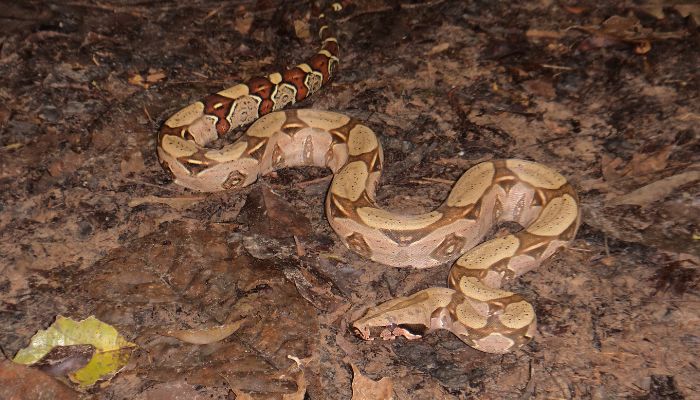Yes, red tail boas do have teeth! They typically have around 20 to 30 small, recurved teeth that are less than a centimeter long. These teeth are not designed for chewing but are incredibly effective for gripping and holding onto prey.
Welcome to the ultimate guide on red tail boas and their teeth! Ever wondered if these fascinating creatures have teeth, what they use them for, or how to handle them safely?
You’re in the right place! We’re diving deep into the anatomy of red tail boa teeth, debunking myths, and even exploring common dental issues these snakes face.
From their feeding mechanisms to what to do if you get bitten, we’ve got all your questions covered. So, let’s slither our way into the captivating world of red tail boas!

Table of Contents
The Anatomy of Red Tail Boa Teeth
Let’s dive into the nitty-gritty of what makes these snake chompers so fascinating.
The Teeth: Number, Size, and Shape
First off, let’s get this straight: red tail boas do have teeth. Oh yes, they do! These aren’t your run-of-the-mill teeth, though. We’re talking about small, recurved teeth that are designed for a very specific purpose. Typically, a red tail boa will have around 20 to 30 teeth.
These teeth are not large; they’re actually quite small, usually less than a centimeter in length. But don’t let their size fool you; they’re perfectly shaped for the job they have to do.
What Are These Teeth Used For?
Now, why would a snake need teeth, you ask? Great question! Red tail boas use their teeth primarily for gripping and holding onto their prey. Imagine you’re a mouse, just minding your own business. Suddenly, a red tail boa strikes and its teeth sink into you.
Those recurved teeth are designed to grip you tightly, making it nearly impossible for you to escape. It’s a bit like those hooks on Velcro; once they’ve got you, you’re not going anywhere.
Comparison with Other Snake Species: How Do Red Tail Boas’ Teeth Differ?
Alright, so we’ve established that red tail boas have teeth, but how do they compare to other snake species? Well, let’s take venomous snakes, for example. Venomous snakes have specialized fangs that they use to inject venom into their prey.
Red tail boas? Nope, no fangs here. Their teeth are more uniform and are not designed for venom delivery.
Then there are egg-eating snakes, which have practically no teeth because, well, eggs don’t run away! Red tail boas need their teeth to catch and hold onto prey, which is often fast-moving and slippery. So, in the grand scheme of snake dental plans, red tail boas have a pretty specialized set-up.
The Fangs vs. Teeth Debate
Alright, let’s clear the air on this one: fangs and teeth are not the same thing, folks! Fangs are specialized teeth designed to inject venom. They’re like the hypodermic needles of the snake world. Regular teeth, on the other hand, are more for gripping and holding.
Now, do red tail boas have fangs? Drumroll, please… No, they don’t! Red tail boas are not venomous, so they don’t have fangs. What they do have are those recurved teeth we talked about earlier, designed for gripping and not for injecting venom.
Why Do Red Tail Boas Need Teeth?
So, we’ve established that red tail boas have teeth but not fangs. But why do they need teeth in the first place? Let’s break it down.
The Role of Teeth in Feeding: Gripping and Holding Prey
First and foremost, those teeth are all about dinner time. When a red tail boa spots a tasty morsel—let’s say, a rat—the snake strikes and uses its teeth to grip the prey tightly. Those recurved teeth are like nature’s Velcro, making it super difficult for the prey to escape.
Social Interactions: Do Teeth Play a Role?
Now, you might be wondering, do red tail boas use their teeth for social interactions? The answer is a resounding no. These snakes are generally solitary creatures and don’t use their teeth for any social cues or interactions.
They’re not out there smiling or showing off their dental work to other snakes, if you know what I mean.
Self-Defense: How Do Red Tail Boas Use Their Teeth for Protection?
Ah, self-defense, the art of keeping oneself safe in a world full of predators. While red tail boas are pretty robust creatures, they can still face threats. In such cases, those teeth can come in handy for biting as a last resort.
However, it’s worth noting that red tail boas are more likely to use constriction or try to escape rather than bite when threatened.
The Feeding Mechanism: How Red Tail Boas Use Their Teeth
Alright, let’s get into the juicy details of how red tail boas use their teeth during feeding. It’s like a well-choreographed dance, but with more scales and teeth involved.
The Strike: How Do They Catch Their Prey?
First up is the strike. Picture this: the red tail boa senses its prey—maybe it’s a mouse or a small bird. In a lightning-fast move, the snake lunges forward and strikes, sinking those recurved teeth into the prey. This isn’t just a random bite; it’s a calculated move. Those teeth grip the prey securely, making escape nearly impossible.
The Role of Teeth During Constriction
Once the teeth have a firm grip, the red tail boa wraps its muscular body around the prey and begins to constrict.
Now, you might think the teeth are done doing their job, but nope! Those teeth continue to hold the prey in place, ensuring it can’t wriggle free during the constriction process.
Swallowing: How Do the Teeth Assist?
After the prey has been subdued, it’s time for the grand finale: swallowing. The red tail boa begins to swallow its prey whole, and here’s where the teeth play a supporting role. They help guide the prey down the snake’s throat, ensuring a smooth journey to the stomach.
Common Dental Issues in Red Tail Boas
Now, let’s switch gears and talk about something less glamorous but equally important: dental issues in red tail boas.
Tooth Loss: Is it Common and Why Does it Happen?
Tooth loss can happen, but it’s usually not a major concern. Red tail boas can lose teeth while feeding or during a struggle with prey. The good news? They can regrow lost teeth, so it’s usually not a long-term issue.
Infections: Signs and Symptoms
Dental infections are another story. Signs to look out for include swelling around the mouth, difficulty eating, or even visible pus. These symptoms are a red flag that something’s not right in tooth-town.
Treatment Options: What Can Be Done if Dental Issues Arise?
If you suspect your red tail boa has a dental issue, it’s time to consult a veterinarian experienced with reptiles. They may prescribe antibiotics for an infection or recommend other treatments. In severe cases, surgical intervention might be necessary.
Handling and Safety: How to Avoid a Bite
Let’s talk about something crucial: how to handle these slithering beauties without getting bitten.
Best Practices for Handling a Red Tail Boa
First things first, always approach your red tail boa calmly and confidently. Quick or jerky movements can startle the snake, and a startled snake is more likely to bite.
When picking up your boa, aim to support as much of its body as possible. Use both hands and let it coil around your arms. This makes the snake feel secure and less likely to bite.
It’s also a good idea to avoid handling your snake during its shedding period or right after it has eaten. These are times when the snake is more sensitive and irritable. Trust me, you don’t want to be on the receiving end of a grumpy snake bite!
What to Do If You Get Bitten
Alright, let’s say the unthinkable happens and you do get bitten. Don’t panic! Remember, red tail boas are not venomous.
First, gently but firmly remove the snake’s teeth from your skin. Then, wash the wound thoroughly with soap and water. Apply an antiseptic and keep an eye out for signs of infection. If you notice anything unusual, like excessive swelling or redness, consult a healthcare provider.
Conclusion
You’ve just journeyed through the fascinating world of red tail boas and their dental anatomy. Now you know that yes, they do have teeth—small, recurved ones designed for gripping prey.
You’ve also learned about their feeding mechanisms, common dental issues, and best practices for handling these incredible creatures.
Armed with this knowledge, you’re well-equipped to appreciate red tail boas for the marvels of nature they are. So whether you’re an aspiring herpetologist, a snake enthusiast, or just plain curious, keep exploring and discovering.
The world of red tail boas is as captivating as it is educational!
FAQ
Ah, the FAQ section, where we tackle those burning questions that just keep popping up. Let’s get to it!
Do Red Tail Boas Bite?
Yes, they can bite, but it’s usually not out of aggression. Most bites occur because the snake is startled, feels threatened, or mistakes your hand for food. Remember, these guys aren’t venomous, so while a bite might hurt and bleed a bit, it’s generally not life-threatening.
What Do a Boa’s Teeth Look Like?
Red tail boas have small, recurved teeth that are less than a centimeter long. They’re designed for gripping and holding onto prey. You won’t see any fangs because, well, they don’t have any!
How Aggressive Are Boas?
Generally speaking, red tail boas are not aggressive creatures. They’re more likely to try to escape a situation they find threatening rather than attack. However, like any animal, they can become defensive if they feel cornered or threatened.
What to Do If a Boa Bites You?
First, don’t freak out. Gently remove the snake’s teeth from your skin. Wash the wound with soap and water, apply an antiseptic, and keep an eye out for signs of infection. If you notice anything unusual like swelling or redness, it’s best to consult a healthcare provider.




0 Comments